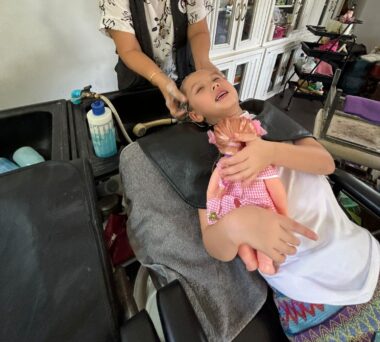How drama therapy helped our daughter conquer haircut anxiety
Moving from tears to triumph thanks to role-play with dolls before a salon visit
Written by |

After years of struggling to get our daughter, Rylae-Ann, to sit for a haircut, we finally had a tear-free experience.
Rylae-Ann was born with aromatic l-amino acid decarboxylase (AADC) deficiency, a rare genetic disorder that affects neurotransmitter production, including dopamine and serotonin. This condition leads to severe motor and developmental impairments, such as weak muscle tone, movement difficulties, and developmental delays.
Fortunately, Rylae-Ann underwent gene therapy at 18 months old. It was an experimental procedure, but it’s now approved for use in the European Union and the United Kingdom, and hopefully soon in the United States. Since this groundbreaking treatment, she’s made remarkable progress.
However, Rylae-Ann still experiences anxiety and struggles to regulate her emotions. My wife, Judy, and I have been working on this issue daily. Progress has been slow but steady, with improvements in many areas, including hospital visits and social skills.
Haircuts, however, remained a challenge. Until recently, she’d had three haircuts since turning 6, each accompanied by tears, screams, and the need to hold her down. We decided to take a different approach.
Drama therapy

Rylae-Ann in a pre-appointment role-play of her trip to the salon, designed to help her manage her anxious feelings about getting a haircut. (Courtesy of Richard E. Poulin III)
Judy is a licensed special education teacher, which has benefited our family tremendously. Although she’s an excellent teacher, it’s different when your own child is the student. She tried drama therapy, which didn’t appear successful at first. The results are not instantaneous, and progress can be followed by setbacks.
Drama therapy uses drama techniques and creative role-playing to help children explore emotions, solve problems, and achieve personal growth. Children can gain insight into their feelings and behaviors in a simulated environment, developing coping skills and reducing anxiety.
In the past, Judy used make-believe play, storytelling, and dolls to act out situations that would cause Rylae-Ann anxiety in real life. This helped our daughter confront her fears in a supportive environment and prepare for real-life situations.
Rylae-Ann’s first tear-free haircut
The first step was for me to step back. Judy wanted to try a different approach. Acting as a team can sometimes overcomplicate a task, or Rylae-Ann can sense my anxiety and transfer it to herself. I gave Judy my full encouragement, though I hoped it wouldn’t end with too much fighting.
Judy began by using dolls. They took Rylae-Ann’s favorite dolls to the bathroom, which became their make-believe hair salon. They went through the entire routine as if they were hairstylists, making the idea of a hair salon a joyous place.
They also role-played with dolls in her room. One of the dolls would become anxious and start crying, and Judy would prompt Rylae-Ann to console it. This play helped Rylae-Ann feel more confident about going to the salon.
These activities continued for several weeks, during which Rylae-Ann didn’t have to get a haircut. We didn’t build up that event. One Saturday morning, Judy spontaneously said, “Hey, Rylae-Ann, let’s take your dolls to get a haircut!”
Rylae-Ann was immediately excited. She grabbed her doll, and they headed to the hair salon for a “hair date.” I stayed back, unsure of what would unfold.

Rylae-Ann clutches her doll as she gets a salon haircut. Weeks before, in a role-play with her mom, she’d comforted the doll’s anxiety. (Courtesy of Richard E. Poulin III)
About 30 minutes later, Judy began sending me pictures of each step of the process. She’d spoken to the hairdresser in advance and scheduled a time when no other customers would be there to avoid unnecessary anxiety and potential public meltdowns.
An hour later, I met them at the salon. I praised Rylae-Ann and took her for ice cream while Judy stayed for her own haircut. Rylae-Ann’s trim was minor, but she completed the entire process. When Judy noticed our daughter’s tears beginning to well up, she prompted the hairdresser to finish quickly and move on to the next step.
Haircuts are small, incremental goals. Though this one was minor in terms of hair removed, it was a significant improvement, and one we can build on. Our family’s journey is a collection of these small moments we cherish.
Note: AADC News is strictly a news and information website about the disease. It does not provide medical advice, diagnosis, or treatment. This content is not intended to be a substitute for professional medical advice, diagnosis, or treatment. Always seek the advice of your physician or other qualified health provider with any questions you may have regarding a medical condition. Never disregard professional medical advice or delay in seeking it because of something you have read on this website. The opinions expressed in this column are not those of AADC News or its parent company, Bionews, and are intended to spark discussion about issues pertaining to aromatic l-amino acid decarboxylase deficiency.






Leave a comment
Fill in the required fields to post. Your email address will not be published.